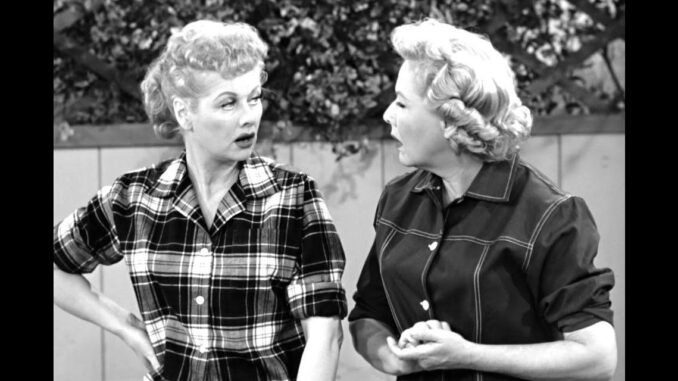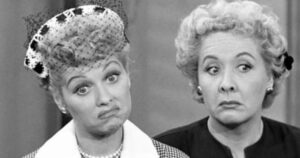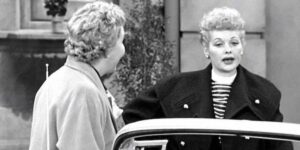
Introduction: More Than Just TV Friends
When you think of I Love Lucy, you probably picture Lucy Ricardo and Ethel Mertz hatching harebrained schemes, sharing laughs, and getting into endless mischief. Their on-screen chemistry was electric, making them one of the most beloved duos in television history. But what if their iconic friendship wasn’t all it seemed to be? Let’s dive into the real story behind Lucy and Ethel’s dynamic and why their relationship was far more layered than fans realize.
The On-Screen Magic: Why Fans Loved Lucy and Ethel
From their first appearance together, Lucy and Ethel’s friendship became the heart of I Love Lucy. Their escapades—from sneaking chocolate off the conveyor belt to stomping grapes in Italy—cemented their status as comedy royalty.

Relatability: Best Friends With Opposite Personalities
Lucy was impulsive and imaginative, while Ethel was pragmatic and (mostly) level-headed. This “opposites attract” dynamic mirrored many real-life friendships, making their bond incredibly relatable.
Unforgettable Comedy Pairings
The duo’s comedic timing was impeccable. Lucy’s physical comedy paired with Ethel’s dry humor was a recipe for endless laughs, creating moments that still resonate with audiences today.
Behind the Curtain: The Real Relationship Between Ball and Vance
Despite their on-screen camaraderie, the off-screen relationship between Lucille Ball and Vivian Vance wasn’t always smooth sailing.
Initial Tensions on Set
When Vivian Vance was cast as Ethel, studio executives reportedly pressured her to look older and less glamorous than Lucille Ball. This caused some resentment and tension early on. Imagine being asked to dull your shine so someone else could sparkle brighter—ouch!
Professional Respect Amid Personal Differences
Though their personalities occasionally clashed, both women deeply respected each other’s talents. Lucille Ball even fought for Vance’s role when studio executives wanted to recast Ethel. Their working relationship thrived on mutual admiration, even if their personal bond wasn’t as rosy.
How Society Shaped Their Friendship
The portrayal of Lucy and Ethel’s friendship reflected societal norms of the 1950s.
The Role of Women in the 1950s
Lucy and Ethel’s antics often centered around their roles as housewives, subtly challenging the era’s expectations for women. Their friendship offered an escape from the mundane and a space for mischief and laughter—a reflection of the yearning for independence many women felt at the time.

Friendship as a Survival Mechanism
In a world dominated by male characters (Ricky and Fred), Lucy and Ethel’s bond became a form of rebellion. They were each other’s support system, reminding viewers that female friendships could thrive in a male-centric world.
Iconic Episodes That Highlighted Their Bond
Let’s take a stroll down memory lane and revisit a few episodes that showcased Lucy and Ethel’s unique dynamic.
“Job Switching”
Who could forget the chaos of Lucy and Ethel working at a chocolate factory? This episode remains one of the most iconic examples of their teamwork—albeit hilariously flawed.
“Lucy and Ethel Buy the Same Dress”
When Lucy and Ethel show up to perform in the same dress, their friendly rivalry comes to life. This episode beautifully highlights how their differences fueled their humor.
“Ethel’s Birthday”
Lucy’s well-meaning attempts to celebrate Ethel’s birthday often backfired, but these moments showcased her genuine affection for her best friend.
Why Lucy and Ethel’s Friendship Endures Today
Decades after I Love Lucy first aired, fans continue to adore Lucy and Ethel’s bond. Why does their friendship still resonate so deeply?
Timeless Humor
Good comedy never goes out of style, and their antics remain laugh-out-loud funny to this day.
A Blueprint for Female Friendships
Lucy and Ethel set the standard for female friendships on TV, inspiring countless duos that followed—from Laverne and Shirley to Leslie and Ann in Parks and Recreation.
The Legacy of Vivian Vance and Lucille Ball
Both women left an indelible mark on Hollywood.
Lucille Ball: The Comedy Trailblazer
Lucille Ball wasn’t just a talented actress; she was a pioneer who paved the way for women in entertainment. Her vision and determination turned I Love Lucy into a groundbreaking series.
Vivian Vance: The Underrated Star
Vivian Vance often played second fiddle to Ball, but her comedic brilliance was undeniable. Without Ethel, Lucy’s antics wouldn’t have been nearly as hilarious.
What We Can Learn From Lucy and Ethel
Lucy and Ethel’s friendship teaches us that no relationship is perfect—but that doesn’t make it any less meaningful. Their bond, both real and fictional, reminds us of the importance of laughter, loyalty, and supporting one another through life’s ups and downs.
Conclusion: A Friendship for the Ages
Lucy and Ethel may not have been as inseparable off-screen as they were on-screen, but their partnership created TV magic that has stood the test of time. Their friendship, full of laughter, love, and a little bit of chaos, remains one of the most cherished aspects of I Love Lucy. Whether you’re watching them scheme, squabble, or support one another, Lucy and Ethel prove that even imperfect friendships can be extraordinary.
FAQs
1. Were Lucille Ball and Vivian Vance friends in real life?
They had a complicated relationship. While they respected each other professionally, their personal friendship had ups and downs.
2. Why did Vivian Vance leave I Love Lucy?
Vivian Vance left due to creative differences and a desire to explore other opportunities, although she later reunited with Ball on other projects.
3. What made Lucy and Ethel’s friendship so iconic?
Their chemistry, comedic timing, and relatable dynamic made them one of TV’s most beloved duos.
4. Did Vivian Vance have to gain weight for her role as Ethel?
Studio executives reportedly wanted her to appear less glamorous than Lucille Ball, leading to efforts to downplay her appearance.
5. How did I Love Lucy influence future sitcoms?
The show set the standard for sitcoms, showcasing strong female leads and redefining comedic storytelling. Its legacy is felt in countless shows today.
